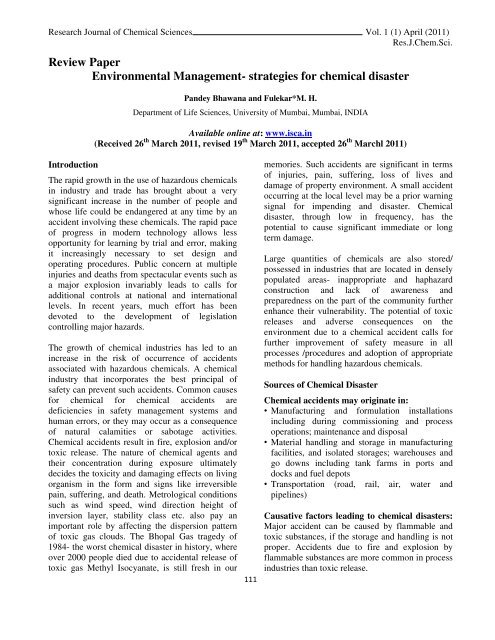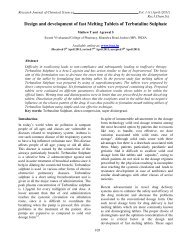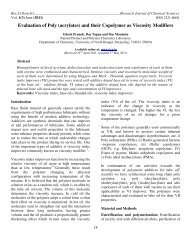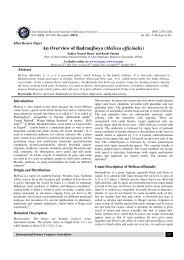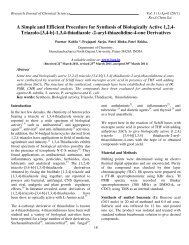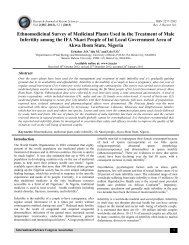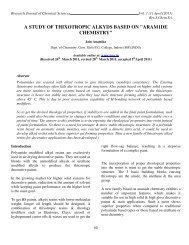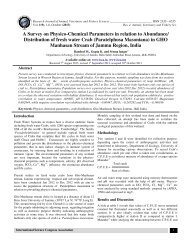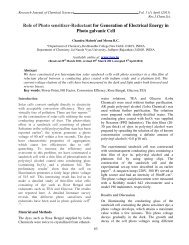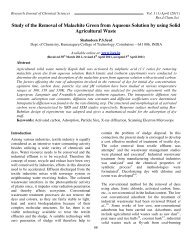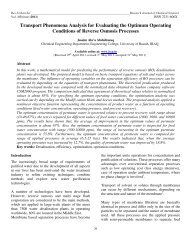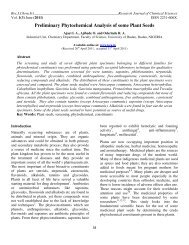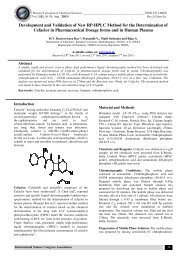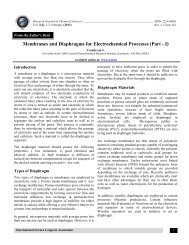strategies for chemical disaster - ISCA
strategies for chemical disaster - ISCA
strategies for chemical disaster - ISCA
You also want an ePaper? Increase the reach of your titles
YUMPU automatically turns print PDFs into web optimized ePapers that Google loves.
Research Journal of Chemical Sciences Vol. 1 (1) April (2011)<br />
Res.J.Chem.Sci.<br />
Review Paper<br />
Environmental Management- <strong>strategies</strong> <strong>for</strong> <strong>chemical</strong> <strong>disaster</strong><br />
Pandey Bhawana and Fulekar*M. H.<br />
Department of Life Sciences, University of Mumbai, Mumbai, INDIA<br />
Available online at: www.isca.in<br />
(Received 26 th March 2011, revised 19 th March 2011, accepted 26 th Marchl 2011)<br />
Introduction<br />
The rapid growth in the use of hazardous <strong>chemical</strong>s<br />
in industry and trade has brought about a very<br />
significant increase in the number of people and<br />
whose life could be endangered at any time by an<br />
accident involving these <strong>chemical</strong>s. The rapid pace<br />
of progress in modern technology allows less<br />
opportunity <strong>for</strong> learning by trial and error, making<br />
it increasingly necessary to set design and<br />
operating procedures. Public concern at multiple<br />
injuries and deaths from spectacular events such as<br />
a major explosion invariably leads to calls <strong>for</strong><br />
additional controls at national and international<br />
levels. In recent years, much ef<strong>for</strong>t has been<br />
devoted to the development of legislation<br />
controlling major hazards.<br />
The growth of <strong>chemical</strong> industries has led to an<br />
increase in the risk of occurrence of accidents<br />
associated with hazardous <strong>chemical</strong>s. A <strong>chemical</strong><br />
industry that incorporates the best principal of<br />
safety can prevent such accidents. Common causes<br />
<strong>for</strong> <strong>chemical</strong> <strong>for</strong> <strong>chemical</strong> accidents are<br />
deficiencies in safety management systems and<br />
human errors, or they may occur as a consequence<br />
of natural calamities or sabotage activities.<br />
Chemical accidents result in fire, explosion and/or<br />
toxic release. The nature of <strong>chemical</strong> agents and<br />
their concentration during exposure ultimately<br />
decides the toxicity and damaging effects on living<br />
organism in the <strong>for</strong>m and signs like irreversible<br />
pain, suffering, and death. Metrological conditions<br />
such as wind speed, wind direction height of<br />
inversion layer, stability class etc. also pay an<br />
important role by affecting the dispersion pattern<br />
of toxic gas clouds. The Bhopal Gas tragedy of<br />
1984- the worst <strong>chemical</strong> <strong>disaster</strong> in history, where<br />
over 2000 people died due to accidental release of<br />
toxic gas Methyl Isocyanate, is still fresh in our<br />
111<br />
memories. Such accidents are significant in terms<br />
of injuries, pain, suffering, loss of lives and<br />
damage of property environment. A small accident<br />
occurring at the local level may be a prior warning<br />
signal <strong>for</strong> impending and <strong>disaster</strong>. Chemical<br />
<strong>disaster</strong>, through low in frequency, has the<br />
potential to cause significant immediate or long<br />
term damage.<br />
Large quantities of <strong>chemical</strong>s are also stored/<br />
possessed in industries that are located in densely<br />
populated areas- inappropriate and haphazard<br />
construction and lack of awareness and<br />
preparedness on the part of the community further<br />
enhance their vulnerability. The potential of toxic<br />
releases and adverse consequences on the<br />
environment due to a <strong>chemical</strong> accident calls <strong>for</strong><br />
further improvement of safety measure in all<br />
processes /procedures and adoption of appropriate<br />
methods <strong>for</strong> handling hazardous <strong>chemical</strong>s.<br />
Sources of Chemical Disaster<br />
Chemical accidents may originate in:<br />
• Manufacturing and <strong>for</strong>mulation installations<br />
including during commissioning and process<br />
operations; maintenance and disposal<br />
• Material handling and storage in manufacturing<br />
facilities, and isolated storages; warehouses and<br />
go downs including tank farms in ports and<br />
docks and fuel depots<br />
• Transportation (road, rail, air, water and<br />
pipelines)<br />
Causative factors leading to <strong>chemical</strong> <strong>disaster</strong>s:<br />
Major accident can be caused by flammable and<br />
toxic substances, if the storage and handling is not<br />
proper. Accidents due to fire and explosion by<br />
flammable substances are more common in process<br />
industries than toxic release.
Research Journal of Chemical Sciences Vol. 1 (1) April (2011)<br />
Res.J.Chem.Sci.<br />
Fire, Explosion, Toxic release, Poisoning,<br />
Combinations of the above,<br />
Impact of <strong>chemical</strong> <strong>disaster</strong>s: In addition to loss<br />
of life, the major consequences of <strong>chemical</strong><br />
<strong>disaster</strong>s include impact on livestock, flora/fauna,<br />
the environment (air, soil, water) and losses to<br />
industry as shown in Figure 1.Chemical accidents<br />
may be categorised as a major accident or a<br />
<strong>disaster</strong> depending upon the number of casualties,<br />
injuries, damage to the property or environment.<br />
Storage and handling: In <strong>chemical</strong> industries,<br />
storage and use of bulk quantities of highly<br />
flammable and toxic substances are often<br />
inevitable, but always poses a threat to the<br />
employees inside the industry, as well as to the<br />
neighbouring community and environment.<br />
Investigations have revealed that a great majority<br />
of the accidents occurred in the storage<br />
installations, as a result of inappropriate design,<br />
poor maintenance or faulty operation of the plant.<br />
Chemical in any <strong>for</strong>m can be safely stored, handled<br />
and used if their physical, <strong>chemical</strong> and hazardous<br />
properties are fully understood and the necessary<br />
safety precautions are taken.<br />
Safety in the storage of hazardous <strong>chemical</strong>s:<br />
• Compatibility and segregation of stored<br />
<strong>chemical</strong>s<br />
• Properties and quantity of <strong>chemical</strong>s to be stored<br />
• Security and sitting of and access of stores<br />
• Construction, nature and integrity of storage<br />
containers<br />
• Loading and unloading of storage containers<br />
• Labelling and re- labelling requirements<br />
• Precautions against accidental release, fire,<br />
explosion and <strong>chemical</strong> reactivity<br />
• Temperature, humidity and ventilation<br />
• Precautions and procedures in case of spillage<br />
• Emergency procedures<br />
• Possible physical and <strong>chemical</strong> changes in<br />
stored <strong>chemical</strong>s<br />
Process and operations: The <strong>chemical</strong> industry<br />
produces a processes and products which<br />
sometimes involve extremes conditions of<br />
temperatures, pressure, hazardous operations or use<br />
of toxic <strong>chemical</strong>s. Major change lead in turn to a<br />
112<br />
series of minor changes as knowledge increase and<br />
processes are optimized. Thus there is need to<br />
develop within the industry, growing awareness of<br />
the systematic approaches to safety particularly in<br />
plant design.<br />
The need to check the design <strong>for</strong> errors and<br />
emissions has been recognized <strong>for</strong> a long time, but<br />
this has traditionally been done on an individual<br />
basis. Experts have usually applied their special<br />
skills or experience to check the particular aspects<br />
of design. The examination of procedure takes a<br />
full description of the process, systematically<br />
questions every part and of it to discover how<br />
deviations from the intension of the design can<br />
occur and decides whether these deviations can<br />
give rises to hazards. It has become increasingly<br />
clear in recent years that although codes of practice<br />
are extremely valuable, it is particularly important<br />
to supplement them with an imaginative<br />
anticipation of hazards when new projects involve<br />
new technology.<br />
The applications of a <strong>for</strong>mal systematic critical<br />
examination to the process and engineering<br />
intensions of the new facilities to assess the hazard<br />
potential of most operations as malfunctions of<br />
individual items of equipments and the<br />
consequential effects on the facility as a whole is<br />
essential to ensure <strong>chemical</strong> safety.<br />
Brief Accident Histories<br />
Numerous major <strong>chemical</strong> accidents happened over<br />
the last several years. Most of these accidents<br />
involved fatalities, and had some significant impact<br />
on people in nearby residential communities. All<br />
involved worker injuries and substantial on-site<br />
property damage. The following list includes some<br />
of the more notable among these table 1 and 2.<br />
Common Factors<br />
These accidents involved different events, varying<br />
circumstances, and a unique set of consequences.<br />
These include the following:<br />
• Inadequate hazard review or process hazards<br />
analysis<br />
• Installation of pollution control equipment<br />
• Use of inappropriate or poorly designed<br />
equipment
Research Journal of Chemical Sciences Vol. 1 (1) April (2011)<br />
Res.J.Chem.Sci.<br />
• Inadequate indications of process condition<br />
• Warnings went unheeded<br />
Primitive Measures<br />
• No <strong>for</strong>est land shall be converted in to non <strong>for</strong>est<br />
activity <strong>for</strong> the sustenance of the industry (Forest<br />
conservation act, 1980)<br />
• No prime agricultural land shall be converted<br />
into an industrial site<br />
• Within the acquired site the industry must locate<br />
itself at the lowest location to remain obscured<br />
from general sight<br />
• Land acquired shall be sufficiently large enough<br />
to provide space <strong>for</strong> appropriate treatment of<br />
wastewater after maximum possible reuse and<br />
recycling<br />
• The green belt between adjoining large scale<br />
plants shall be 1 km.<br />
• Enough space should be provided <strong>for</strong> storage of<br />
solid wastes so that these could be available <strong>for</strong><br />
possible reuse<br />
• Lay out and <strong>for</strong>m of the industry that may come<br />
up in the area must con<strong>for</strong>m to the landscape of<br />
the area without affecting the scenic features of<br />
that place<br />
• Associated township of the industry must be<br />
created at a place having a physicographic barrier<br />
between the industry and township<br />
• Each industry is required to maintain three<br />
ambient air quality measuring station at a 120 C<br />
angle between stations<br />
• Floodplain of the Riverine Systems- At least ½<br />
km from floodplains or modified floodplains,<br />
affected by dams in the upstream or by flood<br />
control systems.<br />
• Transport / Communication system- At least ½<br />
km from the high way lines and railway station<br />
Major settlements<br />
• Distance from settlements is difficult to maintain<br />
because of urban sprawl<br />
• At the time of sitting of the industry if any major<br />
settlements are noted within 50 km the spatial<br />
direction of growth of the settlement must be<br />
assessed<br />
• The industry shall be sited at least 25 km from<br />
the projected growth boundary of the settlement<br />
Environmental impact assessment<br />
• Metrology and air quality<br />
• Hydrology and water quality<br />
• Sites and its surrounding<br />
• Occupational safety and health<br />
• Details of the treatment and disposal of effluents<br />
and the methods of alternative uses<br />
• Transportation of raw material and details of<br />
material handling<br />
• Impact on sensitive targets<br />
• Control equipment and measures proposed to be<br />
adopted<br />
Environmental Guidelines<br />
The following environmental guidelines are<br />
recommended <strong>for</strong> sitting of industries to ensure<br />
optimum use of natural and manmade resources in<br />
sustainable manner with<br />
• Minimal depletion<br />
• Degradation<br />
• Destruction of the environment<br />
The following distances from industrial sites<br />
should be taken into account.<br />
• Ecological and/ or otherwise sensitive areas-At<br />
least 25 km away, depend on the geo-climatic<br />
conditions. The requisite distance shall have to<br />
be increased by appropriate agency.<br />
• Coastal Areas- At least ½ km from high tide line<br />
Strengthening of the present regulatory<br />
framework; augmentation of technical support<br />
function<br />
• A supportive and technology neutral regulation<br />
framework<br />
• Legislation on land-use policy<br />
• Standardization of national codes and practices<br />
• Emphasis on regular safely audit<br />
• Commissioning and decommissioning of<br />
<strong>chemical</strong> industries<br />
• Preparation of on -site and off site plans<br />
• Regular testing of emergency plans<br />
• Need of medical first responders and medical<br />
inventory<br />
• Crises management plans of hospitals<br />
• Concept of mobile hospital and mobile teams<br />
113
Research Journal of Chemical Sciences Vol. 1 (1) April (2011)<br />
Res.J.Chem.Sci.<br />
• Issues related to public health responses, medical References<br />
rehabilitation and harmful effects on the<br />
1. Cheman Abu Bakar and Gold David, Safety and<br />
environment<br />
Health in the Use of Chemicals at Work- A<br />
• Post <strong>disaster</strong> documentation and analysis<br />
training manual, ILO, Geneva,(1993)<br />
Implementing relevant statues on management<br />
of <strong>chemical</strong> substances<br />
• The Environment (Protection) Act, 1986<br />
(amended 1991) and following Rules there<br />
under:<br />
• The Environment (Protection) Rules, 1986<br />
(amended 2004).<br />
• The Manufacture, Storage and Import of<br />
Hazardous Chemicals Rules, 1989 (amended<br />
1994 and 2000).<br />
• The Hazardous Wastes (Management and<br />
Handling) Rules, 1989 (amended 2000 and<br />
2003).<br />
• The Environment Impact Assessment<br />
Notification, 2006<br />
• The Chemical Accidents (Emergency Planning,<br />
Preparedness and Response) Rules, 1996<br />
• Bio-medical Wastes (Management and<br />
Handling) Rules, 1989.<br />
• The Factories Act, 1948 (amended 1987): State<br />
Factory Rules.<br />
• The Inflammable Substances Act, 1952<br />
• The Motor Vehicles Act, 1988 (amended 2001):<br />
The Central Motor Vehicles Rules, 1989<br />
(amended 2005)<br />
• The Public Liability Insurance Act, 1991<br />
(amended 1992): The Public Liability Insurance<br />
Rules, 1991 (amended 1991)<br />
• The Petroleum Act, 1934: The Petroleum Rules,<br />
2002<br />
• The Insecticide Act, 1968 (amended, 2000): The<br />
Insecticide Rules 1971 (amended 1999)<br />
• The National Environment Tribunal Act, 1995<br />
• The Explosive Act, 1884 (amended till 1983):<br />
The Gas Cylinder Rules, 2004. The Static and<br />
Mobile Pressure Vessels (Unfired) Rules, 1981<br />
(amended 2002). The Explosives Rules, 1983<br />
(amended 2002).<br />
2. Fulekar M H, Industrial Hygiene and Chemical<br />
Safety, I.K. International.<br />
3. Fulekar M H, Management of Chemicals at<br />
Work Environment- Manual, Industrial Hygiene<br />
Division, Government of India, Mumbai, (1995)<br />
4. Hazardous Substances Management Division,<br />
Government of India, New Delhi, A Guide to Safe<br />
Road Transport of Hazardous Chemicals,(1995)<br />
5. ILO, Major Hazard Control-a practical manual,<br />
second reprint-Sept., (1996)<br />
6. Ministry of Environment and Forests,<br />
Government of India, New Delhi, Manual on<br />
Emergency Preparedness <strong>for</strong> Chemical Hazards,<br />
(1992)<br />
7. National Disaster Management Authority,<br />
Government of India, National Disaster<br />
Management Guidelines Chemical Disasters,<br />
(2007)<br />
8. Surekha Kadapa Bose, Enviro File, An<br />
Economic Times, Mumbai-special, 14, 5.6. (1998)<br />
9. The Environmental Protection Act, (1986)<br />
10. The Factories (Amendment) Act, (1987)<br />
11. The Forest Conservation Act, (1980)<br />
114
Research Journal of Chemical Sciences Vol. 1 (1) April (2011)<br />
Res.J.Chem.Sci.<br />
Table-1: Major <strong>chemical</strong> accidents- International scenario<br />
Source: Ministry of Environment and Forests, Government of India, New Delhi, Manual on Emergency<br />
S. No. Name of Unit Date of<br />
Accident<br />
Source<br />
Death/Injury/<br />
Missing; losses<br />
1<br />
Terra Industries, Inc.,<br />
Port Neal, Iowa<br />
2 Powell Duffryn<br />
Terminals, Inc. (PDTI),<br />
Savannah, Georgia<br />
3 NAPP Technologies,<br />
Lodi, New Jersey<br />
4 Pennzoil Product<br />
Company<br />
Rouseville, PA<br />
Refinery,<br />
5 Tosco Company<br />
Refinery, Martinez, CA<br />
6 Surpass Chemical<br />
Company, Albany, NY<br />
7 Shell Chemical<br />
Company, Deer Park,<br />
TX,<br />
December<br />
13, 1994<br />
April 10,<br />
1995<br />
April 21,<br />
1995<br />
October 16,<br />
1995<br />
January 21,<br />
1997<br />
April 8, 1997<br />
explosion of an ammonium<br />
nitrate unit<br />
crude luminiu turpentine fire<br />
and hydrogen luminiu release<br />
mixture of sodium<br />
hydrosulfite, Aluminium<br />
powder, potassium carbonate<br />
and benzaldehyde exploded,<br />
triggering a major fire<br />
an explosion and fire erupted<br />
in storage tanks containing<br />
flammable hydrocarbons and<br />
wastewater<br />
a major fire started at a<br />
hydrocracker unit when a<br />
temperature excursion<br />
occurred, causing a piping<br />
elbow to fail catastrophically<br />
a storage tank failed causing a<br />
large spill of hydrochloric acid<br />
(HCl).<br />
June 22, 1997 a large explosion and fire<br />
occurred in an olefins<br />
production unit<br />
4/18<br />
5/2000<br />
residents were<br />
evacuated <strong>for</strong><br />
up to 30 days,<br />
4/numerous<br />
3/3<br />
1/44<br />
43/<br />
1/several<br />
8 Georgia Pacific,<br />
Columbus, Ohio,<br />
September<br />
10, 1997<br />
an explosion occurred in the<br />
phenol/<strong>for</strong>maldehyde reaction<br />
kettle of a resin manufacturing<br />
process<br />
1/13<br />
Preparedness <strong>for</strong> Chemical Hazards, 1992<br />
Table-2: Some major <strong>chemical</strong> accidents in India<br />
115
Research Journal of Chemical Sciences Vol. 1 (1) April (2011)<br />
Res.J.Chem.Sci.<br />
S.<br />
No.<br />
Name of Unit<br />
Date of<br />
Accident<br />
Source Death/Injury/<br />
Missing; losses<br />
GACL, Vadodara, Gujarat September 05, Chlorine gas 4/20/nil<br />
1.<br />
2002<br />
explosion<br />
2. IPCL, Gandhar, Gujarat, December, Chlorine gas Nil/8 workers/ 300<br />
20,2002 release<br />
villagers in<br />
Jageshwer affected<br />
3. IOC Refineries, Digboi, Assam March, 07, Fire in Motor Nil/ Product loss<br />
2003<br />
spirit tank Rs 11.55 crore<br />
4. Ranbaxy Laboratories Ltd Mohali, Jube, 11, 2003 Toluene 2/9/nil<br />
Punjab<br />
5. BPCL Bottling Plant, Dhar, Madhya October, 05, LPG leak from Nil<br />
Pradesh<br />
2003<br />
Tank Lorry<br />
6. Orient Paper mills, Amla Madhya October, 13, Liquid Chlorine Nil/88/nil; 5 m<br />
Pradesh<br />
2003<br />
pipe affected<br />
7. . IDL Gulf Oil, Kukkatpally Hyderabad, November, 25, Explosion 8/15<br />
Andhra Pradesh<br />
2003<br />
8. Anil Enterprises, Zakhira Rohtak, 28.04.2004 Fire in LPG 6/2.nil<br />
Haryana<br />
fired oven<br />
9 HIL Udyogmandal, Kerala 06.07.2004 Toluene fire nil<br />
10 Shyamlal Industries, GIDC Vatva, 12.04.2004 Benzene fire nil<br />
Ahmedabad,Gujarat<br />
11 Chemical Factory, Dombivilli 31.05.2004 Hexane release 1/8/Nil<br />
Maharashtra<br />
fire<br />
12. . Chemplast, Mettur, Tamil Nadu 18.07.2004 Chlorine leak Nil/27/nil<br />
13 Gujarat Refinery, Vadodara 29.10.2004 Explosion in 2/13/nil<br />
slurry settler<br />
14 Ranbaxy Laboratories Ltd Mohali, 30.10.2004 Fire in dryer 1/2/nil<br />
Punjab<br />
room<br />
15 Matrix Laboratory Ltd. Unit 1 05.03.2005 Sodium hydride 8/nil/nil<br />
Kazipally, Medak District Andhra<br />
Pradesh<br />
16 . Gujarat Refinery, Gujarat Ennore, 15.06.2005 Fire Nil<br />
Tamil Nadu<br />
17 Coromondal Fertilizer Ltd., Ennore, 22.07.2005 Ammonia Nil/5/nil<br />
Tamil Nadu<br />
18 Gulf Oil Corporation Ltd Sanathnagarn, 04.10.2005 Explosion/fire 2/2/nil<br />
Hyderabad,<br />
Andhra Pradesh<br />
19 Orchid Chemicals and Pharmaceuticals 03.11.2005 Explosion 2/4/nil<br />
Ltd Alathur, Kancheepuram District,<br />
Tamil Nadu<br />
20 Aurobindo Pharma Ltd Unit-V, IDA<br />
Pashamylaram Medak Dist., Andhra<br />
Pradesh<br />
28.11.2005 Explosion while<br />
drying<br />
cloxaciline<br />
1/4/nil<br />
21 Indian Oil Corporation Ltd.,<br />
Mathura Refinery, Mathura, UP<br />
29.12.2005 Fire 1/nil/nil<br />
116
Research Journal of Chemical Sciences Vol. 1 (1) April (2011)<br />
Res.J.Chem.Sci.<br />
22 Kanoria Chemicals and Industries Ltd. 29.03.2006 Chlorine release 6/23/nil<br />
Renukoot Sonebhadra, Uttar Pradesh<br />
23 Anjana Explosives Ltd Peddakaparthi ., 18.07.2006 Spillage of 5/nil/nil<br />
Nalgonda District, Andhra Pradesh<br />
hazchem<br />
24 Ravi Organics Ltd Muzzaffarnagar, 19.09.2006 Gas release 1/nil/nil<br />
Uttar Pradesh<br />
25 Reliance Industries Refinery Jamnagar, 25.10.2006 Leaked hot 2/nil/nil<br />
Gujarat<br />
vaccum gas<br />
oil catches fire<br />
in air<br />
Source: National Disaster Management Authority, Government of India, National Disaster Management<br />
Guidelines Chemical Disasters, 2007.<br />
Figure-1: Consequences of a Chemical Disaster<br />
117


